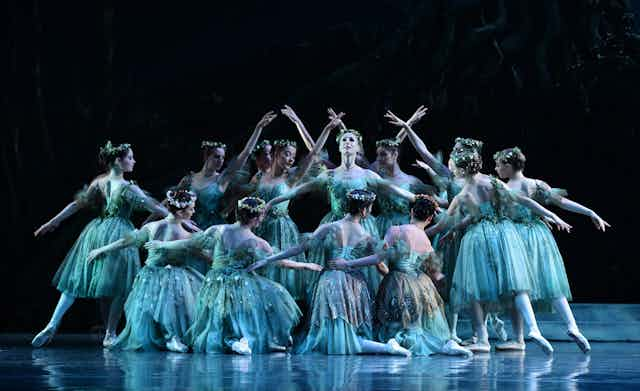The Australian Major Performing Arts Group (AMPAG) is a collection of 28 performing arts companies in Australia. With the exception of a handful of these companies – including Opera Australia, Australian Brandenburg Orchestra, Circus Oz and several others – the group is largely comprised of state-focused opera, dance, orchestra and theatre organisations.
So what are we to make of this group in the light of recent changes to Australian arts funding?
AMPAG contains, according to the Arts Minister George Brandis, the “most significant” performing arts companies in Australia. Touted as flagships for sector leadership, most AMPAG companies have remained resoundingly hushed about the recent incursions into arts funding and the impact on individual artists and the small to medium sector – changes chiefly incited through the recent creation of the National Program for Excellence in the Arts (NPEA).
Who can blame them? After all, they are not part of the wider arts funding landscape. They enjoy a privileged status, ongoing funding terms, different assessment methods – such as no peer review – and criteria that separate them from all others in the sector.
Following the recent cuts to the Australia Council’s funding allocation, the position of these companies has come into sharp focus. While small to medium Australian art organisations and individual artists face significant uncertainty in an increasingly under-resourced and competitive funding environment, the AMPAG companies’ funding arrangements remain secure in a protected set of bilateral agreements between the Commonwealth and the states.
This situation begets two substantive questions:
How did these companies come to be in this position?
To understand where AMPAG came from, we need to look back to the mid-90s. The 1998-99 Annual Report of the Australia Council For The Arts contains a section addressing the Major Organisations Fund. This fund, started about three years earlier, allowed a collection of organisations to move from being funded through the main pool of monies to a hermetic funding stream all of their own.
The story behind how the Major Organisations Fund came into being is somewhat more difficult to trace, as details are sparse.
In what became known as the 1999 Nugent Report, the then 31 major performing arts companies (most of which are those in AMPAG today) were noted to be making a “disproportionate artistic, access and financial contribution to Australian life”.
This disproportionate contribution was evaluated through the lens of the client engagement of the Australia Council and Ministry of the Arts at that time.
The Nugent Report, introduced by Helen Nugent, proposed a bold motion to ensure the ongoing financial security of the heritage arts in Australia. It laid the groundwork for the AMPAG, formalising unending bilateral funding agreements between the Commonwealth and the states.
Sadly, even with such significant and ongoing support, many of those companies faced significant financial mishaps in subsequent years. Several of them, most infamously Orchestra Victoria, ran close to bankruptcy, only to be saved at the last moment by sizeable bail-out manoeuvres.
Two decades on from the development of the Major Organisations Fund, and thereafter AMPAG, the scope of artforms the Australia Council interacts with has expanded exponentially. Examples are plentiful, including support for whole sections of the arts sector that were ignored during the 90s, such as contemporary popular music.
Applications for funding in most artform areas have risen significantly since the relatively modest intakes of the late 90s. Unfunded excellence, the quantitative tool used by the Australia Council to rate the number of excellent (and money-worthy) applications that go unfunded each round, has become increasingly recognised.
So much so, it became a focus of the Creative Australia agenda released late in the term of the previous government.
Shifts and developments
The second, and perhaps more pressing, question emerges in line with significant shifts and developments in the Australian arts sector over the past decade and a half – specifically the recognition of the diversity of practices and organisations making impacts nationally and abroad.
In light of those changes, do the AMPAG companies still offer “a disproportionate artistic, access and financial contribution to Australian life”? That question has haunted much of the recent campaigning in the arts sector around cuts to the Australia Council.
As of now, we do not have a sector in which all companies and artists have the same opportunities to grow their practice and leverage their businesses through funding.
In the Australia Council strategic plan (for 2014-2019), arrangements around the management of AMPAG funding (and administration) were left largely untouched.
While all other artforms have had their boards abolished, as part of the 2013 Australian Council overhaul, the AMPAG section within Council maintains an outdated panel-style structure. Furthermore, AMPAG operates under – and is assessed against – a completely different set of criteria.
While the rest of the arts sector is assessed for its “excellence” and other criteria by peers, AMPAG is merely encouraged to aspire to a far more nebulous term: artistic vibrancy. It seems curious that our flagship companies, the presumed leaders in the arts sector, have no explicit assessment criteria by which their impact can be properly examined.
Given the pressure being applied to the majority of people working in the arts sector in this country, we would be foolish not to consider the roles and inherited rights of these seemingly privileged companies.
If, as Minister Brandis suggests, contestability is critical to arts funding, then surely that should apply to the majority of the monies being administered by the Australia Council, whether for the heritage or contemporary arts.
What do we want to imagine as our possible cultural futures and creative legacy? Whatever we seed now will bloom in the decades to come.

